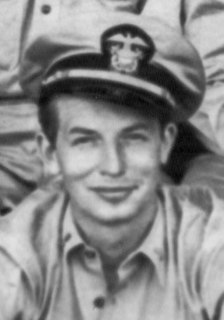Harold John Ellison was a naval aviator and member of Torpedo Squadron 8, the whole of which was lost during the Battle of Midway.

Alexander Vraciu was a United States Navy fighter ace, a Navy Cross recipient, and a Medal of Honor nominee during World War II. At the end of the war, Vraciu ranked fourth among the U.S. Navy's flying aces, with 19 enemy planes downed during flight and 21 destroyed on the ground. After the war, he served as a test pilot and was instrumental in forming the post-war Naval and Marine Air Reserve program. From 1956 to 1958 Vraciu led his own fighter squadron, VF-51, for twenty-two months. He retired from the U.S. Navy with the rank of commander on December 31, 1963. Vraciu later moved to Danville, California, and worked for Wells Fargo.

Harry Brinkley "Brink" Bass was a U.S. Navy pilot who was twice awarded the Navy Cross for his heroic actions in the Pacific theater during World War II. Bass died over Saint Bonnet le Froid, in southern France when his plane was shot down by anti-aircraft fire. USS Brinkley Bass (DD-887) was named in his honor.
William Bowen Ault was a commander in the United States Navy during World War II and a posthumous recipient of the Navy Cross.
William Perry Kephart, born Meyersdale, Pennsylvania, 9 September 1915, enlisted in the United States Naval Reserve 15 August 1937 and was appointed Aviation Cadet 3 months later. After flight training at Pensacola, Fla., he was commissioned Ensign 1 December 1938.
William Wolfe Wileman, born 4 May 1917 in Ventura County, California, United States, graduated from University of California at Berkeley in 1940 then enlisted in the U.S. Naval Reserve, on 12 February 1941, as a seaman second class. After basic training at Oakland, California, he transferred 3 April to the Pensacola Naval Air Station for aviation training; the following day, he received appointment as an aviation cadet. Finishing the basic course at Pensacola in August, Cadet Wileman moved, on the 31st, to the Miami Naval Air Station for advanced training. His flight instruction ended 4 November; on the 5th, Wileman was commissioned ensign in the U.S. Naval Reserve.
Gus George Bebas was an American naval aviator and a recipient of the Distinguished Flying Cross. He was killed during World War II after losing control of a plane during a practice dive in Hawaii. The USS Bebas (DE-10) was named in his honor.
John Drayton Baker was an American Naval aviator who was awarded the Navy Cross for his actions during World War II.
Roy Orestus Hale Jr., born on 10 May 1916 in Monroe, Louisiana, graduated from the U.S. Naval Academy and was commissioned ensign in the United States Navy on 2 June 1938.
Kendall Carl Campbell was born 25 July 1917 in Garden City, Kansas.
Horace Ancel Bass Jr. (1915–1942) was a United States Navy officer and pilot who received the Navy Cross for his actions at the Battle of Midway in June 1942.

Oswald A. Powers (1915–1942) was a United States Navy officer who received the Navy Cross posthumously for his actions in combat during World War II.

Delbert W. Halsey (1919–1942) was a United States Navy officer who received the Navy Cross posthumously for his actions in combat during World War II.

Oswald J. Gaynier (1915–1942) was a United States Navy officer who received the Navy Cross posthumously for his actions in combat during World War II.

Curtis William Howard was a United States Navy officer who received the Navy Cross posthumously for his actions during the Battle of Midway during World War II.
John J. Van Buren (1915–1942) was a United States Navy officer who received the Distinguished Flying Cross and Navy Cross for his actions in combat during World War II.
Edward B. Kinzer (1917–1942) was a United States Navy officer who received the Navy Cross posthumously for his actions in combat during World War II.
John W. Brock (1914–1942) was a United States Navy officer who received the Navy Cross posthumously for his actions in combat during World War II.
Beverly W. Reid (1917–1942) was a United States Navy officer who received the Navy Cross for his actions in combat during World War II in defending the crippled aircraft carrier USS Yorktown (CV-5). He carried out aggressive attacks on two Japanese torpedo planes and was credited with two confirmed "kills". He attended Redemptorist College in New Orleans, before he enlisted in the U.S. Navy on 17 June 1935.

Attack Squadron 35 (VA-35) was an aviation unit of the United States Navy. The squadron's nickname is unknown. Its insignia, a winged dragon, was revised several times during its lifetime. The squadron was first established as Torpedo and Bombing Squadron 2 (VT-2) on 6 July 1925, and was redesignated as VT-2B on 1 July 1927, VT-3 on 1 July 1937, VA-4A on 15 November 1946, and, finally, VA-35 on 7 August 1948. The squadron was disestablished on 7 November 1949. It was the first squadron to carry the VA-35 designation, the second VA-35 was redesignated from VA-34 on 15 February 1950 and disestablished on 31 January 1995.






